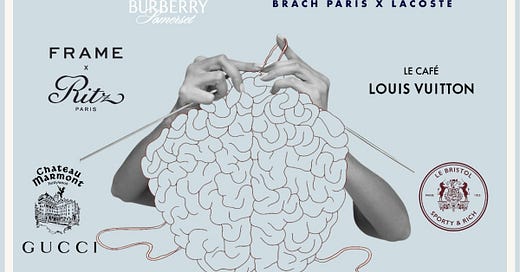Fashion & Hospitality: A Power Couple Story.
Fashion hotel or fashionable hotel? There’s only a (false) step.
Wild co-brandings, beach club takeovers, suites turned into showrooms… Fashion is making its mark across hospitality, sometimes to the point of blurring the lines.
For years, hotels flirted discreetly with fashion. In Paris, at the Lutetia, a Bon Marché personal shopper would welcome you in a private lounge for a bespoke selection, champagne in hand. In London, by the early 2010s, afternoon tea became a pretext for blending pâtisserie savoir-faire with couture storytelling. At the Four Seasons New York Downtown, a stylist from Moda Operandi would show up in-suite, trunks full of runway pieces. The experience was subtle, luxurious, embodied.
Then the trend snowballed. Collaborations between hotels and fashion houses multiplied, often trading subtlety for visibility. Loud partnerships became the norm, with brand names splashed across caps, tote bags, and rooftops. Meanwhile, Missoni opened a branded villa at One&Only Reethi Rah in the Maldives. Burberry draped its tartan over the gardens of The Newt and the Standard Ibiza. Lacoste turned Parisian lobbies into tennis courts. Dolce & Gabbana? Their presence spans from Four Seasons suites to Gurney’s Montauk. Bigger logos may sell faster, but what about the guest experience?
Let’s not (entirely) blame hoteliers; the deal is tempting. Partnering with a couture house or a buzzy brand means instant exposure, access to a broader audience than the usual clientele, and a desirability boost without structural effort. When a Sporty & Rich x Hotel du Cap Eden Roc collab goes viral and sells out in 24 hours, it’s hard not to want to replicate the model endlessly. But push the codes too far, and they lose their meaning.
These partnerships clearly have economic value, yet stacking universes rather than truly blending them often comes at the cost of storytelling. Marketing overshadows narrative, and the hotel risks becoming a mere showroom, or worse, a clone of properties across the world.
Especially now that some fashion houses no longer need partnerships at all. Armed with resources, influence, and a deep understanding of luxury codes, brands like Louis Vuitton are entering hospitality as full-fledged players. The maison recently announced its first hotel in Paris. Chopard has joined the game with 1, Place Vendôme, while Bulgari has emerged as a serious contender in the “Palace hotel” arena, building a chain that fuses Italian jewelry heritage with contemporary hospitality. Saint Laurent opened an ultra-exclusive sushi restaurant with Sushi Park. Prada’s cafés are already in Milan, London, and Tokyo. This isn’t collaboration anymore; it’s full control of the guest experience. For some hoteliers, these brands may already be direct competitors, and they might not even see it coming.
Thankfully, there’s another path. And it’s beginning to take shape.
Vestiaire Collective, the luxury resale platform, has rolled out an ambitious international campaign, “Spend Less, Get More.” The message? Buy that designer dress second-hand, and you’ll save enough for a dream weekend. At Zero, we were privileged to help shape this vision, curating a selection of ten partner hotels worldwide with both a strategic and curatorial eye (see the campaign here).
In a different register, to celebrate its 60th anniversary, Il Pellicano partnered with Highsnobiety to tell stories through an editorial, culture-first approach. No flashy branding, but a capsule of objects designed as a narrative extension of the hotel, a natural continuation of Issimo, their pioneering e-shop that’s become a benchmark in curated e-commerce.
Another example: Kim Jones, former Artistic Director at Dior Homme, recently created an exclusive collection for Aman (Aman Essentials). A discreet yet exemplary collaboration: here, fashion doesn’t overshadow hospitality, it complements it.
More unexpected initiatives are emerging too. Zara, for instance, has launched its own travel platform. While the project raises questions around values and sustainability, it highlights a shift: even fast fashion brands want to occupy the space of emotion, memory, and experience. And yes, its owner Amancio Ortega has even recently acquired a hotel in Paris, because why not?
Because this is what the next generation of travelers is craving: fewer logos, more emotions. Fewer capsule collections, more capsule moments. They don’t dream of a brand in the window; they dream of a place with real style. The kind you can’t copy-paste.
Fashion can elevate hospitality, if it doesn’t dress it up… and steal the spotlight.
1. Collaborate with intention, not opportunism.
A good partnership should feel like a dialogue, not a marketing stunt. It must enrich your narrative, embody your values, and speak to your guests, not just the algorithm. Keep control of the storytelling and ask yourself what it says, not just what it sells.
2. Create style, not noise.
Better to leave a lasting impression than to attract just anyone. Don’t hand over your story to another brand. If your hotel becomes a backdrop, you risk losing its soul. Opt for subtle touches over total makeovers: editorial capsules, signature objects, reimagined uniforms. The goal? Sophistication, not saturation.
3. Think sustainable, without greenwashing.
Fashion and hospitality share a responsibility: to evolve towards more conscious models. Avoid throwaway collabs and branded trinkets. Focus on craftsmanship, local sourcing, and thoughtful editions. And why not reinvent the hotel shop with a curation of rare vintage pieces instead of the usual luxury brand lineup?








Well said: capsule moments is what we want